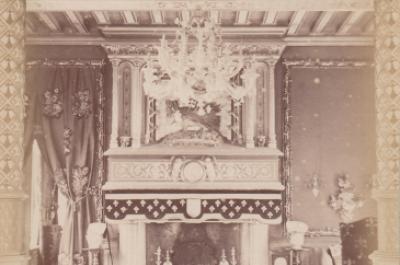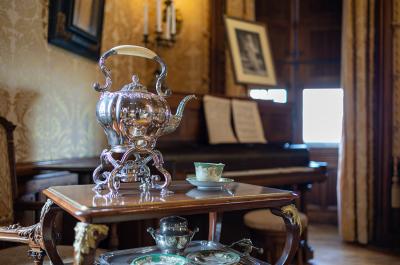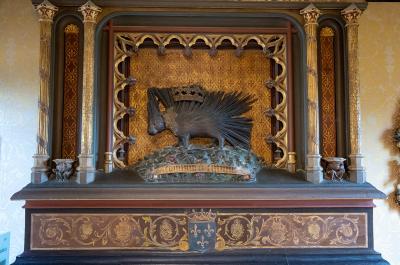The Great Salon sits at the extremity of the West Wing and overlooks the Loire. Its decoration is the work of Jules Potier de la Morandière, architect of Viscount Joseph Walsh whose family owned Chaumont just before the de Broglies. The Viscount Joseph Walsh was responsible for the polychrome fireplace with the porcupine (the emblem of King Louis the Twelfth), as well as the wood panelling around the lower part of the wall, which has a linenfold decoration. The Prince and Princess de Broglie kept most of the decoration and had most of the walls covered with a yellow silk brocatelle comparable to that in the billiard room.
The furniture comprises a confidante sofa, a fumeuse chair and a tea-table, among other pieces, in diverse styles and periods. It allows us to appreciate the typical mood of the lifestyle of the wealthy in the late 19th century, who accumulated furniture and furnishings.
Tea-time at the de Broglies
Gabriel-Louis Pringué, a writer and close friend of the Broglies, was a regular guest at Chaumont. In his book Trente ans de dîners en ville (30 years of dinners in town), he wrote: “Tea-time began at five o'clock. The princess sometimes took tea at seven… Two footmen brought in an enormous dresser, sliding it along the floor on a pair of shafts. It contained the silver samovar and all the requisite utensils: cups, stacks of cakes, pâtés, rillettes and hot muffins in covered silver dishes, along with Spanish wines, whisky and port. Guests at the Château served themselves at their own convenience, whenever they felt like it. At eight o’clock, the footmen came back armed with their shafts and the ‘sedan-chair dresser’ was returned to the pantry.”
The fireplace
The fireplace in the Great Salon was built in the mid 19th century by the architect Jules Potier de la Morandière, at the request of the Château’s owner, Viscount Joseph Walsh. This large, polychrome fireplace takes its inspiration from several fireplaces gracing the Royal Château of Blois. It is adorned with a porcupine, the emblem inherited by Louis XII from his father Charles of Orléans, eldest son of prince Louis, Duke of Orléans.
In 1393, Louis of Orléans established a chivalric order “of the porcupine”, comprising 25 noble knights experienced in weaponry. All were expected to wear a purple coat, against which gleamed the gold chain necklace with a porcupine pendant and the motto: COMINUS ET EMINUS (near and far).
This motto reflects the belief of the time, according to which the porcupine is able not only to protect itself from any nearby enemies, with its spikes, but also to fire them like arrows against anyone posing a threat from afar. It is an allusion to both the clemency and severity of the King as well as the offensive and defensive qualities of the porcupine.



